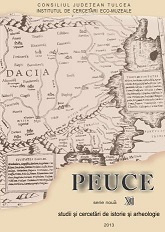Consideratii preliminare privind lampile grecesti si elenisticede la Orgame / Argamum (com. Jurilovca, jud. Tulcea)
Preliminary considerations on the Greek and Hellenistic lamps from Orgame/Argamum (Jurilovca, Tulcea County)
Author(s): Florin TopoleanuSubject(s): Archaeology
Published by: Institutul de Cercetari Eco-Muzeale Tulcea - Institutul de Istorie si Arheologie
Keywords: Orgame / Argamum; North-Western Pontic Area; Archaic; Classic and Hellenistic lamps; central tube lamps; open basin lamps; Jurilovca; Razelm Lake; local manufacturing; ceramics kilns
Summary/Abstract: The ruins of the Greco-Roman city Orgame / Argamum lie 6,5 km east from Jurilovca, Tulcea County, at Capul Doloşman; quite early on, it became the focus of scholars due to the archaeological excavations systematically carried on since 1926. Orgame / Argamum was founded by colonists from Milet in the middle of the 7th century BC and was continuously inhabited until the beginning of the 7th century AD. The chronology of the main historical periods is generally established notwithstanding the modest scale of the excavation. Since the Roman and, especially, Late Roman vestiges completely overlap the remnants of earlier periods, the Hellenistic phase of the city is less known. This paper describes for the first time the Greek lamps from Orgame, a ceramic category important both for the chronological ’fine tune’ and for the identification of the city’s commercial partners. The 19 lamps analyzed are dated between the end of the 7th century BC and the first years of the 2nd century BC, confirming thus, once more, the pre Roman evolution of Orgame. Of these, four artefacts are complete (or could be completely restored) and six only have a complete body profile. Most of them (twelve artefacts) were gathered from the nearby beach, at the base of the promontory on which the settlement was constructed; four lamps were excavated in the city, two were excavated in the tumulus necropolis, and one was excavated in the extramural sector, westward from the Late Roman fortification. The earliest lamps (dating from the Greek Archaic and Classical periods) have an open body and are fitted with a central tube or a conical protuberance on the inside. By contrast, the Hellenistic lamps preserve many more morphological elements useful in their identification. Unfortunately, most pieces were accidentally found or came from secondary positions, thus their value in dating the stratigraphical context is low. The lot analyzed is, both typologically and chronologically, quite diverse, though scant and probably incomplete. The fine ware – issued in well established Greek production centres – stands out; alongside, artefacts loosely modelled out of coarse clay have been discovered. The possibility that the latter could have been produced at Orgame is not to be excluded; this assumption may be backed by the ceramic kilns of a similar age excavated here. Finally, the spatial distribution of the lamp finds (with a significant concentration on and around the beach) implies reconsidering the dimensions of an intensely populated area during the Greek period – completely lost after the partial collapse of the cliff that presumably occurred sometime in the Late Roman period.
Journal: Peuce (Serie Nouă) - Studii şi cercetari de istorie şi arheologie
- Issue Year: XI/2013
- Issue No: 11
- Page Range: 43-65
- Page Count: 23
- Language: Romanian

